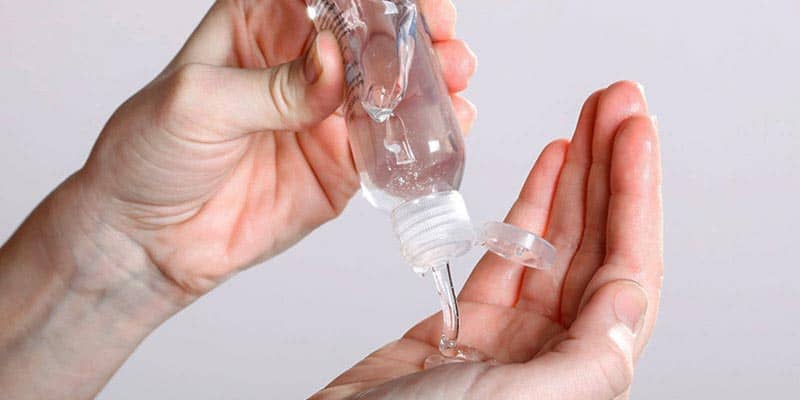في ظل الإفراط في استخدام جل التعقيم إليك أضراره

في ظل الإفراط في استخدام جل التعقيم إليك أضراره
يتم استخدام جل تعقيم اليدين، الذي يحتوي على نسبة 70% من الكحول، في حالة عدم توافر ماء وصابون ومنشفة، وذلك منذ أن بدأت جائحة كورونا في التفشي ببقاع الأرض. فأصبح ذلك الجيل هو أحد أهم السلع التي يتم البحث عنها بالمتاجر. وتكمن الفائدة الرئيسية في أنه يمكن استخدامه في أي مكان، ويسهل حمله طوال الوقت.
يساعد الكحول كأحد مكونات جل التعقيم على قتل الجراثيم وبعض الفيروسات والبكتيريا، لكنه لا يقضي على كل الفيروسات أو الجراثيم، حيث إن بعضا منها لا يتأثر بمفعول الكحول.
وفيما يلي مزيد من التفاصيل من تقرير نشره موقع “ويبمد” WebMD حيث يضع مطهر أو معقم اليدين في المرتبة الثانية بعد الماء والصابون للحماية من فيروس كورونا المُستجد وباقي الجراثيم والميكروبات، علاوة على ضوابط ومحاذير محددة لاستخدامه.
للتعقيم المؤقت
يمكن أن يقضي معقم اليدين على الجراثيم، لكنه لا ينظف اليدين من الأوساخ. ويعد الماء والصابون هو الوسيلة الأساسية والآمنة لتنظيف اليدين من أي أوساخ. ولا يقتصر دور الماء والصابون على التنظيف والتعقيم فحسب، بل إنهما في الواقع أكثر فعالية في قتل الجراثيم والفيروسيات.
وتعد رغوة الصابون أكثر فعالية في التخلص من المواد الكيميائية التي يمكن أن تعلق باليدين.
لا يخترق المخاط
أظهرت إحدى الدراسات أن معقم اليدين ربما لا يعمل بشكل جيد إذا علق المخاط على اليدين. ويقول الخبراء إن سمك المخاط يساعد في حماية الجراثيم، ومن ثم فإن غسيل اليدين بالماء والصابون هو أفضل طريقة لتعقيمها بعد العطس، خاصة المصابين بنزلات البرد والإنفلونزا.
نسب الكحول
يوصي المركز الأميركي لمكافحة الأمراض والوقاية منها CDC باستخدام مطهرات لليدين تحتوي على 60% كحول على الأقل. ولهذا ينصح الخبراء بضرورة التأكد من نسبة الكحول المدونة ضمن مكونات مطهر اليدين لضمان التخلص من أكبر قدر ممكن من الجراثيم والفيروسات عند الاستعمال، إضافة إلى الاعتماد فقط على العبوات مُحكمة الإغلاق.
قابل للاشتعال
يتم تقييم مدى جودة جل تعقيم اليدين بمدى احتوائه على نسب مناسبة من الكحول، وبالتالي، فإنه مادة قابلة للاشتعال. لذا يجب التأكد من الاحتفاظ بزجاجات مطهر اليدين في مكان آمن بعيدًا عن اللهب أو الحرارة العالية.
مكونات سامة
كشفت توصيات إدارة الغذاء والدواء الأميركية FDA أن الميثانول، الذي يدخل في تركيبة أكثر من 100 علامة تجارية من منتجات تعقيم الأيدي، يمكن أن تمتصه البشرة.
وتشمل الأعراض، التي يمكن أن يتسبب فيها امتصاص البشرة للميثانول، الغثيان والقيء والصداع وتشوش الرؤية والعمى والغيبوبة والتلف الدائم للجهاز العصبي أو حتى الموت.
ويوصي الخبراء بتجنب استخدام أي منتجات لتعقيم اليدين تحتوي على مادة الميثانول في مكوناتها.
خطر على الأطفال
يجب الاحتفاظ بعبوات وزجاجات معقم اليدين بعيدًا عن متناول الأطفال الصغار، لأنه مجرد رشف كمية قليلة منه ربما تتسبب في إصابة الطفل الصغير بتسمم كحولي.
تشقق وجفاف الجلد
يمكن أن يؤدي الكحول الموجود في معقم اليدين إلى جفاف الجلد وتشققه، وهو ما يعد في حد ذاته سببًا لتسرب الجراثيم إلى الجسم. ينبغي استخدام قدر بسيط بما يكفي للتنظيف الموضعي عند استخدام معقم اليدين في كل مرة لمنع حدوث ذلك.
الاستخدام الخاطئ
يجب أن تكون اليدان خاليتين من الأوساخ حتى يمكن أن يعمل معقم اليدين بالطريقة الصحيحة للقضاء على الجراثيم. ينصح الخبراء بضخ كمية قليلة من معقم اليدين وفركها جيدًا لمدة 20 ثانية ثم تعاد الكرة لمرة ثانية حتى تجف اليدين والأصابع.
مواضيع أخرى :






